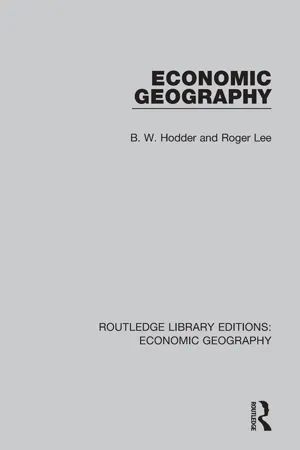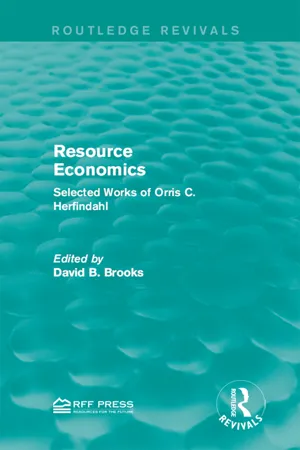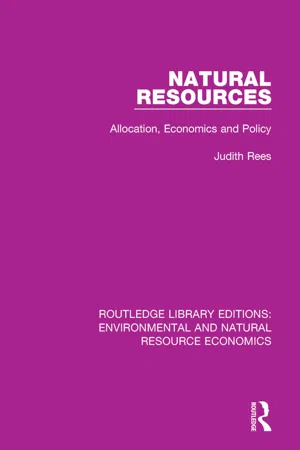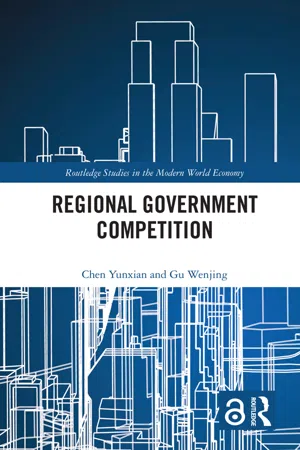Economics
Resource Allocation
Resource allocation refers to the process of distributing available resources among various uses. In economics, it involves making decisions about how to allocate limited resources to meet unlimited wants and needs. This process is crucial for optimizing efficiency and maximizing the production of goods and services within an economy.
Written by Perlego with AI-assistance
Related key terms
Related key terms
1 of 4
Related key terms
1 of 3
6 Key excerpts on "Resource Allocation"
- eBook - ePub
- B. W. Hodder, Roger Lee(Authors)
- 2015(Publication Date)
- Routledge(Publisher)
Economic activity consists of several closely related stages: the generation of wants and needs known collectively as demand; the transmission of information about the nature of demand to firms; the transfer of information from firms to resource owners about the demand for resources; the response of resource owners by mobilizing their resources; the movement of resources to firms in return for income; the manufacture of goods; the transmission of information from firms to consumers about the availability of goods; the movement of goods to consumers in exchange for payment; the consumption of goods by final consumers. All these aspects of economic activity refer to those tangible, often visible, processes which are apparent in everyday life and whose energy creates the economic landscape. But it will already be clear that there is another and perhaps more fundamental aspect of economic activity – decision making – which provides the impetus and direction for these processes.Three sets of decisions
All economies have somehow to make at least three fundamental and interdependent sets of economic decisions. These are allocation decisions – what commodities shall be produced and in what quantities; production decisions – how and where these goods shall be produced; and distribution decisions – for whom they shall be produced.ALLOCATION DECISIONS
In a society where economic activity consists of the concerted action of large numbers of individuals, decisions about which goods and services and in what quantities these goods and services are to be produced are exceedingly complex. Individual views on the most effective use of scarce productive resources will vary widely, so that the economy must make value judgments about the kinds of goods to be produced and quantity judgments about how much of each good should be produced. In all economies the criteria of efficiency and utility should govern the decisions because allocative efficiency is measured by the ratio between useful output and total input. The effect of such decisions is to allocate resources to those productive agencies capable of producing the chosen goods.PRODUCTION DECISIONS
Having decided on the type and amount of goods to be produced, the next set of decisions involves the organization of production. Production is a process involving firms in the acquisition of premises at a suitable location in order to combine resources in an efficient productive ratio and to set in motion the distribution of the finished products. Again, the role of utility modifies any purely physical interpretation of efficiency. It is often not possible to use resources in the occupations, locations and ratios in which they have the highest level of productivity (that is, the highest output-input ratio), because the constraints of the utility priorities of society may well modify this simple relationship. Both resources and demands are distributed unevenly over the surface of the earth. Some communities, therefore, must attempt to compensate for their lack or relative scarcity of certain resources by utilizing their limited resource endowment in ratios which make extensive use of plentiful resources and intensive use of scarce resources. Alternatively they may, by military or economic conquest, extend their access to a wider range of resources or, by developing trading connections, import those goods which are demanded by their consumers but which are difficult, if not impossible, to produce with their own resource endowment. As a result of these considerations, decisions about methods of production need to be made at the same time as decisions about which goods and services are to be produced, because the output of goods depends not only upon utility priorities and resource endowment, but also upon the ways (production techniques) in which the resources can be combined in productive service. - eBook - ePub
Resource Economics
Selected Works of Orris C. Herfindahl
- David B. Brooks(Author)
- 2015(Publication Date)
- Routledge(Publisher)
with ALLEN V. KNEESE)THE ROAD WE HAVE TRAVELLEDIn this last chapter we look back over the material we have covered in the context of a number of important general questions. What have we learned about economic theory that helps analyze problems in the management of natural resources? Where are the difficulties? Is economic theory of help in predicting what the future has in store for society? Can it help us to make decisions that will presumably affect future events or will we be swept along willy-nilly to unknown and perhaps terrible future states?Our objective has been to provide an account of those parts of allocation theory that seem to be especially useful in the analysis of problems in the management of natural resources and which do not receive much attention in the usual courses in economic theory. The first step was a rapid review of the basic ideas of allocation theory, including the sources of market failure, this being central to the later concern with resource problems that are not wholly encompassed within private economic entities.Substantial attention was given to the idea, and some of the basic techniques, of maximization subject to side conditions or restrictions. One of these techniques, linear programming, was given considerable attention along with the closely related tool of input-output analysis, since these tools have and will play an important role in the empirical analysis of resource management systems. Although basic ideas are important, the reader will want to consult specialized sources to develop a certain amount of technical expertise in manipulating these tools.Since some important natural resource problems are part of the more general problem of capital accumulation, far more space has been devoted to capital theory and related matters than in a conventional text. A simple model of capital accumulation was presented. Some of the implications of steady growth of various types were brought out. We have taken the liberty of giving considerable emphasis to our own comments on the problem of how rapidly capital should be accumulated and of how natural resources might be introduced into the problem. Two types of more specific problems involving management over time were discussed, each of them involving the economic system in interaction with a natural system. The first of these natural systems was the comparatively simple one of mineral depletion, the second was a simple example, cast in terms of a fishery, of the immensely more complicated problem of managing economic-biological systems. - eBook - ePub
Natural Resources
Allocation, Economics and Policy
- Judith Rees(Author)
- 2017(Publication Date)
- Routledge(Publisher)
Assuming that existing renewable resources are to be managed to maximize their net value in use, allocation decisions should be left to the sovereign consumer, to individual revealed preferences for specific environmental goods and services. For this to happen, prices (or preference measures) must be established for all those resource products hitherto unvalued by the market. The decision to undertake investment to increase the level of renewable resource flows available in the future (this includes conservation) should also, in theory, be based on consumer preferences and should be taken on broadly the same appraisal criteria as apply in the private sector. However, this appraisal task is made much more complex by the need to include a wide set of social costs and benefits in the analysis. Although decisions on how to allocate existing resource flows between competing users and on investment in new supplies are closely interrelated, the issues, problems and appropriate economic tools are rather different in the two cases. Therefore, attention, in this chapter, will be focused on the allocation questions, while Chapter 8 will be concerned with conservation and investment decisions. Most theoretical economists suggest that the principles governing the management of available resource flows are the same for all types of renewable resource. As Dasgupta (1982, p. 201) puts it, ‘the conceptual apparatus that is needed to study the economics of pollution control is the same as are required for fisheries, ground water basins, forestry and so on’. It is not, therefore, necessary to discuss the vast range of individual renewable resources which now have been subject to economic analysis. 1 Instead, the approach, its limitations and use in practice will be assessed using pollution control as the type example - eBook - ePub
- Chen Yunxian, Gu Wenjing(Authors)
- 2018(Publication Date)
- Routledge(Publisher)
3Resource Allocation in “the four phases”Regional government competition, which is achieved through the effective allocation of regional resource factors, can be interpreted in both the broad and narrow sense. The former covers competition in the allocation of total factors, i.e. operational resources, non-operational resources and quasi-operational resources, while the latter tends to take place in the structural adjustment and effective allocation of quasi-operational resources.The realization of corporate profits and the growth of regional income are both issues of input and output and cannot do without the investment and allocation of resources, but the ways that resources are defined and allocated have become dynamic processes of constant adjustment and change. On the one hand, the concept of resources has transitioned from traditional physical resources to the expanding scope of intangible resources. On the other hand, the dominant factors affecting their allocation are constantly shifting from simple factors to total factors such as technology and innovation. Porter (1990) points out that a country’s economic development undergoes four phases, which are characterized as factor-driven, investment-driven, innovation-driven and wealth-driven. From the perspective of the development of global economies, the Resource Allocation pattern of regional government has also experienced dynamic changes from factor-driven, investment-driven, innovation-driven and to wealth-driven. The policy eco-environment of regional government may vary with these phases, and so will the Resource Allocation means depending on the particular time given, so regional government must effectively judge the core driving force of economic growth over a given period of time and adopt a series of resources allocation means to guide the ecology of policy. - eBook - ePub
- Cynthia Metcalf, Rhonda Atkinson, Rhonda Atkinson(Authors)
- 2017(Publication Date)
- Research & Education Association(Publisher)
Reduce Wants: Another way to deal with scarcity is to get a society to not want so much of an item. If people did not want so much, then an item would not be scarce. In the long term, however, this is difficult to do.There are four ways that society can use its existing resources to reduce scarcity and obtain the maximum satisfaction possible. These universal economic goals are sometimes referred to as the 4 E’s:• Allocative E fficiency• Production E fficiency• E quity• Full E mploymentUniversal Economic GoalsAllocative Efficiency (Economic Efficiency) —A society achieves allocative efficiency if it produces the types and quantities of goods and services that most satisfy its people. Allocative efficiency is using our limited resources to produce the right mix of goods, so that society makes more of what people want, and less of what people do not want. Failure to do so wastes resources by producing a lot of things people do not want and few things that people want.Production Efficiency (Technical Efficiency) —A society achieves production/technical efficiency when it is producing the greatest quantity of goods and services possible from its resources at a minimum cost, thus using fewer resources and increasing production quantities. In turn, scarcity is reduced. Failure to do so is also a waste of resources. There are three methods that can be used to achieve production efficiency:• not using more resources than necessary;• using resources where they are best suited;• using technology that minimizes costs.Equity —A society wants the distribution of goods and services to conform with its notions of “fairness.” Equity is not necessarily synonymous with equality. There is no objective standard of equity, and all societies have different notions of what constitutes equity. Three widely held Standards of Equity are as follows:• Contributory standard - eBook - ePub
Resource Allocation and Management in Defence: Need for a Framework
Need for a Framework
- (Author)
- 2013(Publication Date)
- KW Publishers(Publisher)
1Thus, economics is basically concerned with allocation of resources among competing ends to maximise attainment of the ends and since the means are limited, it emphasises the necessity for exercising choice in the achievement of goals.Many of the military problems can be analysed in this conceptual framework. Limited resources mean limited output. Attention gets focussed on ‘outputs’. After conceptual clarity about these ‘outputs’ is achieved, the next point that comes up is that, owing to the limitation of resources, a choice must be made as to what quantities of each ‘output’ need to be produced to get the ‘best value for money’. Therefore, an important field of enquiry is how these choices are being made and on what basis.An economist naturally analyses military problems in terms of his accustomed framework, using logic of choice. “Military problems can be formulated as economic problems of maximisation, subject to constraints.”2 Constraints, of course, are of resources. We are not talking only of budgetary resources. The nation turns over to the military Services certain resources, some of which are specialised ones—bases, military capital equipment and trained manpower inherited from past periods. Others are general resources like the budget, which, with certain limitations, can be spent on anythingThe task of the Services and of the Ministry of Defence (MoD) is to use these resources in such a way that our military power or ‘military worth’ is maximised. So, when we approach the question of optimum utilisation of resources for maximisation of the military worth, a total look is required at both the ‘inherited resources’, which are specialised, as also the general resources like the defence budget. “Of course, there is no way of measuring military power or military worth—in the general case—any more than there is a way of measuring an individual’s, a family’s, or a firm’s utility or preference function.” But, as Hitch goes on to add, “The conceptual framework helps greatly even if we can’t fill all the empty boxes. It tells us how to seek solutions.”3
Index pages curate the most relevant extracts from our library of academic textbooks. They’ve been created using an in-house natural language model (NLM), each adding context and meaning to key research topics.
Explore more topic indexes
Explore more topic indexes
1 of 6
Explore more topic indexes
1 of 4





